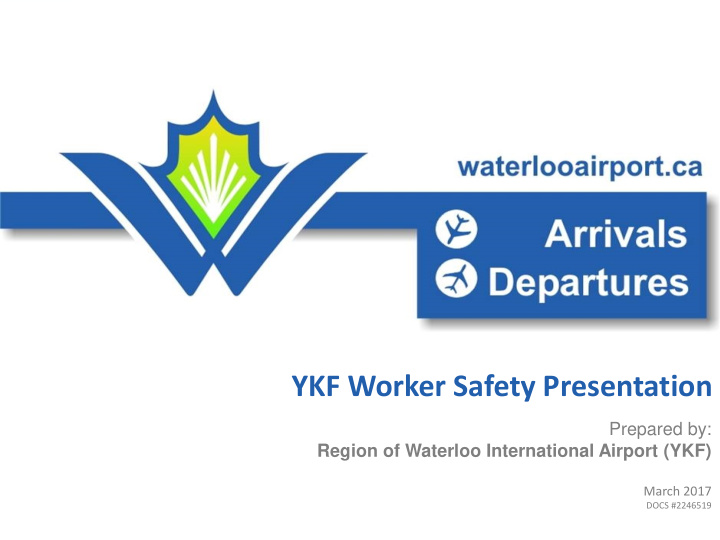



YKF Worker Safety Presentation Prepared by: Region of Waterloo International Airport (YKF) March 2017 DOCS #2246519
WORKER SAFETY - “Head to Toe” Personal Protective Equipment & Fatigue Management
PERSONAL FATIGUE MANAGEMENT (1) Fatigue is a state of physical or mental weariness that results in reduced alertness. It is the result of inadequate quantity or quality of sleep.
PERSONAL FATIGUE MANAGEMENT (2) Being awake for 24 hours or more is equivalent to being legally too drunk to • drive (Blood Alcohol Content = 0.10%) Fatigue can have a negative impact on your personal health and • family/social life Being fatigued can make you a risk to your own safety, to your • co-workers, and to others
PERSONAL FATIGUE MANAGEMENT (3) Acute Fatigue Chronic Fatigue Constant severe state of Short term sleep loss due to tiredness heavy physical or mental Effects: work * Lasts longer than 6 months Effects: * Flu-like symptoms & not Short term * relived by rest * Reversed by managing Reversed by sleep and * symptoms with doctors relaxation
PERSONAL FATIGUE MANAGEMENT (4) Signs of Fatigue: * Tiredness * Sleepiness * Irritability * Depression * Loss of appetite * Digestive problems * Increased susceptibility to illness
PERSONAL FATIGUE MANAGEMENT (5) Fatigue has negative effects on the workplace that can lead to workplace incidents. Reduced: Increased: * Decision making ability * Tendency for risk taking * Communication skills * Errors in judgment * Productivity and performance * Sick time (absenteeism) * Reaction time * Incident rates
PERSONAL FATIGUE MANAGEMENT (6) What can I do to manage fatigue? Adopt Good Sleeping Habits • M ost people need 7-9 hours of sleep per day. Implement a regular bedtime • routine and schedule • If your shift changes, adjust your bedtime gradually
PERSONAL FATIGUE MANAGEMENT (7) What can I do to manage fatigue? Maintain a Healthy Lifestyle • A void dehydration and drink plenty of fluids; at least 2 litres per day • Eat right (low-fat, high- protein foods can increase alertness)
PERSONAL PROTECTIVE EQUIPMENT Personal Protective Equipment (PPE) refers to any clothing or equipment that is used by a worker in order to protect them from injury or illness
TYPES OF PPE Many jobs require PPE. Always wear the appropriate PPE for the hazards that you may encounter on the job or as required: Hand & Finger * Eye Protection * Protection * Hearing Protection Foot Protection * * Head Protection
HEAD PROTECTION In Construction zones, hard hats are worn because of the potential for head injury. Situations that could cause injury when working: Below other workers or machinery * * Around or under conveyor belts Around exposed energized conductors * Where there may be overhead obstructions *
EYE PROTECTION In Canada: 700 Canadian workers sustain eye injuries every day on the • job due to improper eye protection, resulting in lost time. It is estimated that 90% of these injuries could • be prevented with proper eye wear. Source: Canadian National Institute for the Blind 2015 cnib.ca
EYE PROTECTION Face Mask / Respirator Safety Goggles Safety Glasses
EYE PROTECTION (2) Activities associated with wearing the appropriate level of eye protection: * Welding, cutting, Dusty environments * and brazing * Chemical gases, vapours, or liquids * Sawing, Grinding Sunlight or Harmful * * Spray painting Light
H EAR ING PROTECTION HEARING LOSS PREVENTION: You don’t • know what you’ve lost until it’s gone! • Sound levels of a jet engine range from 120dB – 140 dB! • To get the full benefit of hearing protection, they should be worn wherever noise hazards are present.
H EAR ING PROTECTION (2) At the airport, there are certain areas that may require hearing protection. Examples include (but not limited too): * Airside * Mechanical rooms * Generator rooms Wearing your hearing protection in these areas will: * Reduce the amount of noise reaching the ears * Reduce the risk from hearing loss
HAND & FINGER PROTECTION Gloves protect hands and forearms from: * Cuts Abrasions * * Burns Puncture Wounds * Contact with hazardous chemicals * * Some electric shocks Blood borne pathogen diseases * If the job task requires wearing gloves, wear the right gloves for the right job!
ALL personnel are required to wear a high visibility, reflective safety vest when in certain areas. Check your airport’s policy on required locations for wearing safety vests! Baggage halls * Movement area *
FOOT PROTECTION • Safety-toed footwear is worn to prevent crushed toes when working around heavy equipment or potential falling objects Safety footwear must be CSA certified (green patch) • • Safety boots also provide protection from stepping on sharp objects and some di-electric protection
FOOT PROTECTION (2) • Inclement weather can create slipping hazards, so be safety conscious in footwear! Wear slip-resistant safety shoes or boots to • prevent slipping!
REMINDER: General Safety Reporting Methods
Jeff Caswell Supervisor, Regulatory Affairs and Administration 519.648.2256 ext. 8512 jcaswell@regionofwaterloo.ca FlyYKF @FlyYKF
Recommend
More recommend